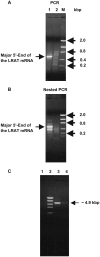Cloning, gene organization and identification of an alternative splicing process in lecithin:retinol acyltransferase cDNA from human liver
- PMID: 15474300
- PMCID: PMC3843125
- DOI: 10.1016/j.gene.2004.06.043
Cloning, gene organization and identification of an alternative splicing process in lecithin:retinol acyltransferase cDNA from human liver
Abstract
Lecithin:retinol acyltransferase (LRAT) catalyzes the synthesis of retinyl esters in many tissues and is crucial for the transport and intracellular storage of vitamin A. LRAT expression is highly regulated in the liver. In this study, we have cloned and sequenced the full-length LRAT mRNA from human liver and identified its 5'- and 3'-ends. Full-length LRAT mRNA comprises 5023 nt with a predicted ORF of 230 amino acids, a short 5'UTR, and a relatively long 3'UTR of 4 kb containing several polyadenylation signals and AU-rich regions. Based on alignment of this mRNA with human genomic DNA in the GenBank database, the human LRAT gene spans about 9.1 kbp and consists of two exons and a relatively long 4-kbp intron. Further analysis of normal liver revealed a minor alternative splicing variant which lacks a 103 nt polynucleotide contained in the 5'UTR of the full-length LRAT transcript. This variant predicts that the LRAT gene is organized into three exons and two introns, as reported for LRAT cloned from retinal pigment epithelium (RPE) cells. These two LRAT mRNA variants are also present in testis, which is known to express LRAT and contain retinyl esters. Major and minor transcription start sites for human liver LRAT mRNA were identified and the sequence of the upstream proximal promoter region was retrieved from the GenBank database and physically analyzed for the presence of putative cis-acting elements essential for basal transcription. This region contains a TATA box, CCAAT box and Sp1 site, which are apparently conserved in mouse and rat LRAT genes. Our results provide evidence that multiple LRAT mRNA transcripts, which are expressed in a tissue-specific manner, may result from several mechanisms including differential splicing of the 5'UTR region and the use of multiple polyadenylation signals in the 3'UTR.
Figures



References
-
- Andreola F, Giandomenico V, Spero R, De Luca LM. Expression of a smaller lecithin:retinol acyl transferase transcript and reduced retinol esterification in MCF-7 cells. Biochem Biophys Res Commun. 2000;279:920–924. - PubMed
-
- Chen CY, Shyu AB. AU-rich elements: characterization and importance in mRNA degradation. Trends Biochem Sci. 1995;20:465–470. - PubMed
-
- Conne B, Stutz A, Vassalli JD. The 3′ untranslated region of messenger RNA: a molecular dhotspotT for pathology? Nat Med. 2000;6:637–641. - PubMed
Publication types
MeSH terms
Substances
Associated data
- Actions
- Actions
Grants and funding
LinkOut - more resources
Full Text Sources
Molecular Biology Databases
Research Materials

